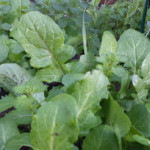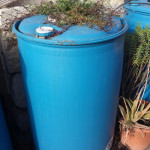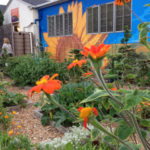A quick and easy cool-season vegetable garden
 After a rain, the weeds sprout — so quickly that you can almost hear them. What if the green that magically appeared wasn’t weeds, but food plants?
After a rain, the weeds sprout — so quickly that you can almost hear them. What if the green that magically appeared wasn’t weeds, but food plants?
Your cool-season vegetable garden can be just that easy!
And, this time of year, you can lay the groundwork in a single weekend. So what are you waiting for?
Pick proper plants
Get your seeds ready now! For a quick mid-winter project like this one, you will need to choose the certain kinds of plants. Here’s a formula: leafy greens + cool-season legumes + ecosystem-builders.
Leafy greens: For an insta-garden you will want vigourous varieties, not the delicate ones. Try the leafy-er members of the broccoli family (like kale, collards, mustard greens, amara, and the varieties of turnip that are grown for greens). Arugula is perfect for this. Try vigorous varieties of chard (skip the fussier “rainbow chard”). In our climate, skip spinach. Lettuces are likely too delicate for this, but some vigorous cos/romaine varieties might work fine.
Cool season legumes are peas and fava beans. Select any kind of shelling pea, snowpea, soup pea that tickles your imagination. Fava beans (Vicia faba) are also known as broad beans or ful, and there are many varieties to choose from.
Lupines are another cool-season legume with nitrogen-fixing abilities. There is one Italian variety of lupine that you can eat as a fermented food. But the rest of them — including some California natives — are flowers which feed and support beneficial insects, pollinators, and hummingbirds.
Ecosystem-builders: If your soil structure is tight or compacted, include daikon radish or burdock; their thick roots will help do the work of opening your soil. To grow-your-own material for your compost, you might include alfalfa or buckwheat.
When you’re planting lots of broccoli family plants, don’t overlook cilantro. In my observation, it seems to help distract the Cabbage White Butterfly, whose little larvae so hungrily devour your kale and collards.
For your urban wildlife you might include pollinator-attractant plants such as calendula, or California natives such as California poppy or clarkia. (January is the end of the “best time” window for planting California wildflowers and California native plants.)
While you’re at it, check out Cityscape Seeds — grown on L.A. urban properties — and help support a project to localize and adapt vegetable plant varieties to our So.Calif. growing conditions.
Build your soil
If you have a patch that “used to be a vegetable garden” but it’s been ignored for a few months, you’re most of the way there! Just add some compost, even the bagged stuff, and you’re ready to plant!
If you’re starting with bare soil that’s currently growing nothing, there’s still plenty you can do. Get plenty of compost, and spread it on top of that soil. On a day when your soil isn’t totally soaked and marshy from rainwater, use your garden fork to till the compost in as best as you are able.
A bit of technique: back up as you work, so that you never walk on (never compact) the growing spaces once you have worked them.
If your soil wasn’t all that great, be sure to select plenty of soil-builders from the plant list above: legumes to enrich your soil, and daikon radish to help break it open.
Seed with the Rain
Watch your weather reports. When a rainstorm is forecast, or perhaps as it begins, go out to your patch and sow your seed.
In my experience, everything grows better with the rains. The rains seem to push the seeds deeper into the crevases of the soil, so that they get nestled in well.
The rains seem to ward off the birds, so that they don’t eat as much of your seeds. And in my garden, the rains send feral cats into hiding, so that they don’t dig up my new seedbed!
With this damp winter and cool nighttime temperatures, your soil will retain moisture for a long, long time. That is why feral vegetables grow so well — easily, effortlessly. Try it!
- For greater detail on growing “feral” vegetables, download my free info sheet “Vegetables gone Wild!” (pdf)
- more about the legume family
- How to harvest leafy greens: “Cut and Come Again harvesting“


